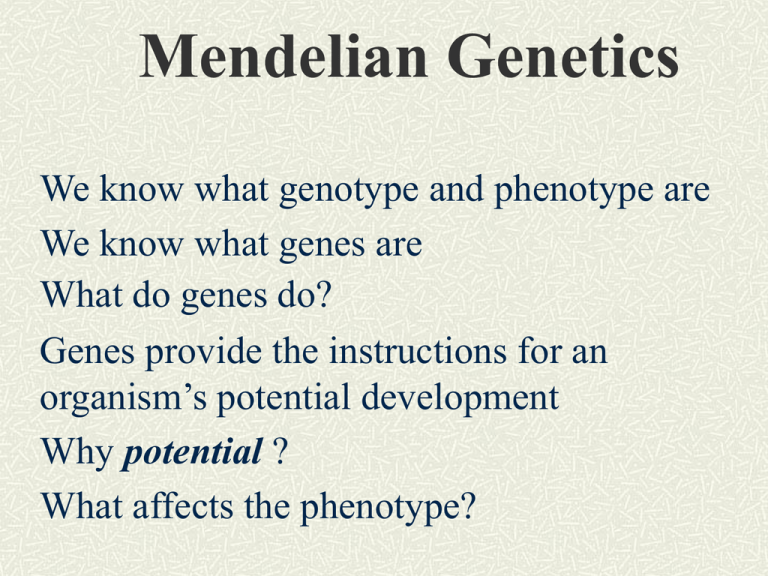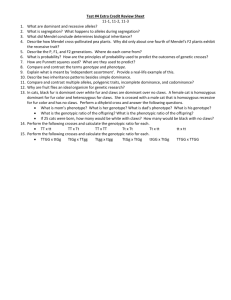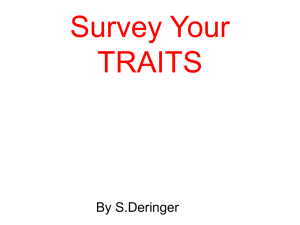Mendelian Genetics
advertisement

Mendelian Genetics We know what genotype and phenotype are We know what genes are What do genes do? Genes provide the instructions for an organism’s potential development Why potential ? What affects the phenotype? Mendelian Genetics Phenotype is affected by genotype, environment chemicals & other genes Example: 1 Why is this horse black & white? His genotype is either EE or Ee for black color Why the white markings? Mendelian Genetics Remember the phenotype is affected by other genes as well The “other” gene is called the Tobiano gene, which overrides and cancels any color production at all in those locations Why the white markings? The gene for black hair production has been turned “off” or overridden at those locations Mendelian Genetics Example: 2 – Your height The genes you received from mom & dad determine your genotype However, environmental factors, diet and hormone involvement affect the phenotype Can different genotypes result in the same phenotype? Can the same genotypes result in different phenotypes? Mendelian Genetics So someone who is “supposed” to be 6’3” but doesn’t get the nutrition probably won’t reach that height The opposite could be true for someone who is “supposed” to be 5’8” and gets too much hormone, they could be taller Gregor Mendel (1822-1884) 1843 – admitted into Augustinian Monastery 1854 – began series of breeding experiments with pea plants - no knowledge of mitosis or meiosis Mendelian Genetics 1865 – reports conclusions of experiments KEY POINTS: - began studying the inheritance of only 1 trait at a time - controlled matings - kept accurate records of outcomes Why pea plants? Easy to handle, produce lots of offspring, short life cycle, variation existed Mendelian Genetics Mendel allowed the plants he had to Self-pollinate (selfing) – pollen fertilizes an egg from the same flower For many generations to attain true-breeders There were 7 traits he studied in his experiments 1. Flower & seed coat color 5. Pod shape 2. Seed color 6. Stem height 3. Seed shape 4. Pod color 7. Flower position Mendelian Genetics Mendelian Genetics Mendel had to be sure these plants didn’t Self-pollinate To manage this he removed the male parts (anthers) and used them where he desired to Cross-pollinate – pollen fertilizes an egg from a different flower Phenotypes of the resulting seeds (peas) were analyzed and then planted to produce the next gen Mendelian Genetics P-generation P X P = F1 F1 X F1 = F2 (through self-fertilization) Monohybrid crosses Reciprocal crosses – done in both directions Ex. Wrinkled female x smooth male AND Smooth female x wrinkled male If the results are the same… If the results are different… Mendelian Genetics F1 generation always showed traits of one parent, not both (dominant vs recessive) F2 generation showed traits of both parents (3:1) (1:2:1) Mendel reasoned that there were “factors” (genes) that were passed from parent to offspring Since the 2 traits he was examining replaced each other they were assumed to be alternative forms of the same trait (alleles) Homozygous / heterozygous Punnett squares Mendelian Genetics Medel’s principle of segregation The two members of a gene pair (alleles) segregate from each other during gamete formation This means that all offspring carry one allele from each parent – the combination of alleles in the offspring is completely random T1T2 x T3T4 T1T3 / T1T4 / T2T3 / T2T4 Branch or Fork Diagram Mendelian Genetics Branch or Fork Diagram Mendelian Genetics What do punnett squares or the branch diagram actually show us? Possible outcomes, not actual – the percentages are for each offspring produced Wild-type allele – the allele of a gene that is present in the highest frequency in a wild population *mutations to these genes could produce nonfunctional, partially functional or totally absent proteins Mendelian Genetics *If the function of the protein is lost due to the mutation it is called a loss-of-function mutation (usually recessive) Mendelian Genetics Mendel’s Principle of Independent Assortment – genes on different chromosomes behave independently in gamete production This means that the passing of one gene has no correlation with the passing of a second gene (TtGg) – the passing of the ‘T’ has no correlation with the passing of the ‘G’. Complete a punnett square for the cross TtGg x ttGg TG Tg tG tg TG tG tg tG tg Tg tG tg tG tg tG tg TG Tg tG tg TtGG TtGg ttGG ttGg tG tg tG tg TG Tg tG tg TtGG TtGg ttGG ttGg TtGg Ttgg ttGg ttgg tG tg tG tg TG Tg tG tg TtGG TtGg ttGG ttGg TtGg Ttgg ttGg ttgg TtGG TtGg ttGG ttGg TG Tg tG tg tG TtGG TtGg ttGG ttGg tg TtGg Ttgg ttGg ttgg tG TtGG TtGg ttGG ttGg tg TtGg Ttgg ttGg ttgg Mendelian Genetics Dihybrid cross – cross between 2 individuals that are ‘dihybrid’, meaning they are both hybrid for 2 traits (TtGg x TtGg – 9:3:3:1) If you were to test 2 traits at the same time… P generation: TTGG x ttgg both are ‘true-breeders’ therefore the F1 would be TtGg, completely hybrid Trihybrid cross – cross between 2 individuals that are hybrid for 3 traits P generation: TTGGBB x ttggbb both are ‘truebreeders’ therefore the F1 would be TtGgBb, completely hybrid Mendelian Genetics Monohybrid cross produces ____ 2 phenotypes Dihybrid cross produces ____ 4 phenotypes Trihybrid cross produces ____ 8 phenotypes Can you come up with a mathematical formula to be able to determine the number of phenotypes produced in a genetic cross? n 2 n = number of independently assorting, heterozygous gene pairs Mendelian Genetics Monohybrid cross produces ____ 3 genotypes Dihybrid cross produces ____ 9 genotypes Trihybrid cross produces ____ 27 genotypes Can you come up with a mathematical formula to be able to determine the number of phenotypes produced in a genetic cross? n 3 n = number of independently assorting, heterozygous gene pairs Pedigree Analysis Genetic evaluation of human inheritance is difficult because it is not ethically possible to control the matings Therefore we often rely on pedigree analysis to determine patterns of inheritance (how it is passed from gen to gen) How do we know if genes are passed? We rely strictly on phenotypes over several generations Proband – affected individual in which the pedigree is discovered Pedigree Symbols Male Female Affected / Unaffected Carrier / Heterozygous Mating Parents with 1 boy and 1 girl (birth order) Carrier of sex-linked Stillbirth Twins Marriage of blood relatives Pedigree Analysis Generations – numbered with Roman numerals (II) Individuals – numbered with Arabic numerals (2) Refer to a particular person as II - 2 *If affected individual is born to unaffected parents: probably caused by recessive trait *If affected individual is born to affected parents: May be caused by dominant or recessive trait Recessive Traits Require homozygosity May have originated from a mutation Recessive Traits Ex. albinism In U.S. – 1 in 17,000 of the white population 1 in 28,000 of the African American pop 1 in 10,000 of the Irish population Of those affected by rare recessive traits… 1. Most have “normal” parents (heterozygous) 2. Matings between heterozygous individuals should produce a 3:1 ratio of “normal” progeny 3. When both parents are affected, homozygous, their offspring will usually exhibit the trait Dominant Traits Expressed when heterozygous or homozygous Dominant mutant alleles produce phenotypes due to gain-of-function mutations they produce new genes with new functions Ex. Woolly hair, Achondroplasi, Brachydactyly, Marfan syndrome Because mutant dominant alleles are rare it is rare to find an individual homozygous for the mutant dominant allele Dominant Traits Characteristics of dominant inheritance 1. An affected individual must have an affected parent 2. Usually does not skip generations 3. Heterozygous individual will transmit the mutant gene to half their progeny Mendelian Genetics How can one determine the genotype of an individual exhibiting the dominant phenotype? Test cross – cross of an individual of unknown genotype, usually dominant, with a homozygous recessive individual to determine the unknown Data resulting from genetic crosses rarely match the “expected” ratios It is the job of the geneticist to do statistical analysis to understand the significance of the deviation from the predicted results Questions 1. A purple-flowered pea plant is crossed with a white-flowered pea plant. All the F1 plants produce purple flowers. When the F1 plants are allowed to self-pollinate, 401 of the F2 have purple flowers and 131 have white flowers. What are the genotypes of the parental and F1 generation plants? ANSWER: P – PP x pp F1 – Pp x Pp F2 – probably deduce a 1:2:1ratio Questions 2. Consider 3 gene pairs Aa, Bb, and Cc, each of which affects a different character. In each case the uppercase latter signifies the dominant allele and the lowercase letter the recessive allele. These 3 gene pairs assort independently of each other. Calculate the probability of obtaining a the following: a. an AaBBCc zygote from a cross of individuals that are AaBbCc x AaBbCc Questions b. an AaBBcc zygote from a cross of individuals that are aaBBcc x AAbbCC c. an A_B_C_ phenotype from a cross of individuals that are AaBbCC x AaBbcc d. an aabbcc phenotype from a cross of individuals that are AaBbCc x aaBbcc Questions 3. In chickens, the white plumage of the leghorn breed is dominant over colored plumage, feathered shanks are dominant over clean shanks, and pea comb is dominant over single comb. Each of the gene pairs segregates independently. If a homozygous white, feathered, pea-combed chicken is crossed with a homozygous colored, clean, single-combed chicken and the F1 are allowed to interbreed, what proportion of the birds in F2 the will produce only white, feathered, pea-combed progeny if mated to a colored, cleanshanked, single combed birds? Questions 4. In tomatoes, red fruit color is dominant to yellow. Suppose a tomato plant homozygous for red is crossed with one homozygous for yellow. Determine the appearance of: a. the F1 tomatoes b. the F2 tomatoes c. the offspring of a cross of the F1 tomatoes back to the red parent d. the offspring of a cross of the F1 tomatoes back to the yellow parent Questions 5. In maize, a dominant allele A is necessary for seed color, as opposed to colorless (a). Another gene has a recessive allele wx that results in waxy starch, as opposed to normal starch (Wx). The two genes segregate independently. An AaWxWx plant is testcrossed. What are the phenotypes and relative frequencies of offspring? Questions 6. In guinea pigs, rough coat (R) is dominant over smooth coat (r). A rough-coated guinea pig is bred to a smooth one, giving eight rough and seven smooth progeny in the F1 generation. a. What are the genotypes of the parents and their offspring? b. If one of the rough F animals is mated to its rough parent, what progeny would you expect? Questions 7. In cattle, the polled (hornless) condition (P) is dominant over the horned (p) phenotype. A particular polled bull is bred to three cows. Cow A, which is horned, produces a horned calf; polled cow B produces a horned calf; and horned cow C produces a polled calf. What are the genotypes of the bull and the three cows, and what phenotypic ratios do you expect in the offspring of these three matings? Questions 8. Consider the following pedigree, in which the allele responsible for the trait (a) is recessive to the normal allele (A): a. What is the genotype of the mother? b. What is the genotype of the father? c. What are the genotypes of the children? d. Given the mechanism of inheritance involved, does the ratio of children with the trait to those without match what would be expected?











